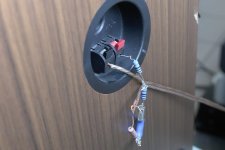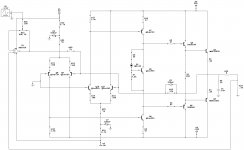I posted that article on the CFA Topology thread. It is a very good implementation. It would need to be tweaked for more voltage. It is essentially a homebrew version of the commercial 1V RMS transconductance amps that cost thousands.
What kind of bandwidth do you require ?I posted that article on the CFA Topology thread. It is a very good implementation. It would need to be tweaked for more voltage. It is essentially a homebrew version of the commercial 1V RMS transconductance amps that cost thousands.
What kind of bandwidth do you require ?
DC to 1 kHz at a minimum. DC to 20k would be ideal
Woofertester, please make this a real amplifier that can actually be used to listen to music (in term of power and bandwidth, and also connectivity) and not "just" a measurement device (USB only?)
I am sure the (DIY) market is there for such an amp.
I am sure the (DIY) market is there for such an amp.
That is on my list of things to try. Do you think it practical to develop a box to implement the idea you describe? You could use the box with any generic amp to make it force current.
Transforming any generic (voltage) amp to a current amp using an additional box
involved many risks.
I think a dedicated current output amp is more safe particularly as you need bandwidth extended to DC.
What maximal "power" would you need for an 8 Ohm load ?
Transforming any generic (voltage) amp to a current amp using an additional box
involved many risks.
I think a dedicated current output amp is more safe particularly as you need bandwidth extended to DC.
What maximal "power" would you need for an 8 Ohm load ?
50-75 watts at 8 ohms for most speakers. 2A RMS will drive most speakers to Xmax in free air at Fs. For the big speakers, 48V rms and 4A rms is required.
Very few to no speakers are 8 ohms at Fs. My monster speaker is 12 -14 ohms at Fs. 14 ohms at small signal and 12 ohms at Xmax.
High efficiency speakers can be hundreds of ohms at Fs.
It is better to specify max Vrms and max Irms. The small amp should be 24V rms and 2A rms.
It could happen this way
It would be simple: Someone starts producing new active speakers and their exceptionally clean sound will be praised everywhere. Someone else does reverse engineering and notices that surprisingly the amplifiers got current feedback, making them transconductance amplifiers instead of voltage amplifiers. Soon after other companies will start producing as great sounding active speakers.
I think if you really look closely, then current drive could be very exciting from a performance point of view, but as it's a paradigm shift I have big doubts of how to make it commercially fly.
It would be simple: Someone starts producing new active speakers and their exceptionally clean sound will be praised everywhere. Someone else does reverse engineering and notices that surprisingly the amplifiers got current feedback, making them transconductance amplifiers instead of voltage amplifiers. Soon after other companies will start producing as great sounding active speakers.
Sound of real current-drive system https://www.youtube.com/watch?v=ZGma4Q-qgcw
real nice!
would you put link to itun project in UKR/RUS language?
Hi
you can laugh of this setup,
I am listening to the music from a few months with 98 Ohm resistors series with 4 Ohm 91dB speaker. It was the experiment but survived from this time.
The result is velvet, smooth highs, but with lots of the details and sound richness. Beautiful voices, horns, saxs, trumpets, etc. SQ.
Negative impact on bass driver damping is hard to hear.
I can recommend to experiment with similar solutions to have current drive with voltage drive.
The speakers are Saba Acoustic monitors 80, the amp JVC A-X9.
Similar improvment I marked with Yamaha A-1 amp.
And now you do not need to care about extra low resistance speaker cables😉
you can laugh of this setup,
I am listening to the music from a few months with 98 Ohm resistors series with 4 Ohm 91dB speaker. It was the experiment but survived from this time.
The result is velvet, smooth highs, but with lots of the details and sound richness. Beautiful voices, horns, saxs, trumpets, etc. SQ.
Negative impact on bass driver damping is hard to hear.
I can recommend to experiment with similar solutions to have current drive with voltage drive.
The speakers are Saba Acoustic monitors 80, the amp JVC A-X9.
Similar improvment I marked with Yamaha A-1 amp.
And now you do not need to care about extra low resistance speaker cables😉
Attachments
JVC A-X9...love the amp, I used to have one!
Now I am using NIKKO Alpha 230 for similar experiments. I never went so high with resistor impedance...maybe I will try it too. Or use variable resistor or half of L-pad. (I do have real transconductance amplifier LM1875 based in other system and that is great sounding amp)
Current drive is no laughing matter!
Now I am using NIKKO Alpha 230 for similar experiments. I never went so high with resistor impedance...maybe I will try it too. Or use variable resistor or half of L-pad. (I do have real transconductance amplifier LM1875 based in other system and that is great sounding amp)
Current drive is no laughing matter!
JVC A-X9...love the amp,

(I do have real transconductance amplifier LM1875 based in other system and that is great sounding amp)
Current drive is no laughing matter!

is it real stable in this configuration?
please show a sketch at least🙂
My modded old Optimus (radio shack) car amp.
very fine schematic, however back emf might still interfere with the sound via voltage feedback part...
Please show us your circuit.(I do have real transconductance amplifier LM1875 based in other system and that is great sounding amp)
take a look at this thread...Joe Rasmussen has a nice schematics of LM3875, I have not built that one yet, but one day I may...
I built this...
http://www.diyaudio.com/forums/chip...att-transconductance-current-amplifier-6.html
I built this...
http://www.diyaudio.com/forums/chip...att-transconductance-current-amplifier-6.html
My modded old Optimus (radio shack) car amp.
This looks elegant. Is the output inverting with respect to the input?
- Home
- Amplifiers
- Solid State
- Current drive for Loudspeakers

